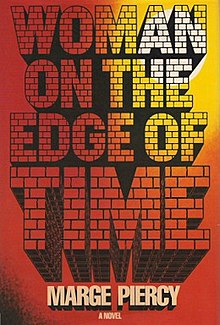Woman on the Edge of Time

Cover of the Fawcett 1988 edition (paperback)
|
|
| Author | Marge Piercy |
|---|---|
| Country | United States |
| Language | English |
| Genre | Science fiction, Utopian fiction |
| Publisher | Alfred A. Knopf |
|
Publication date
|
1976 |
| Media type | Print (Hardcover and Paperback) |
| Pages | 369 |
| ISBN | |
| OCLC | 2020128 |
| 813/.5/4 | |
| LC Class | PZ4.P618 Wo PS3566.I4 |
Woman on the Edge of Time (New York: Alfred A. Knopf, 1976) is a novel by Marge Piercy. It is considered a classic of utopian "speculative" science fiction as well as a feminist classic.
Thirty-seven-year-old Hispanic woman Consuelo (Connie) Ramos, recently released from forced detention in a mental institution for drug-fueled child abuse which led her to lose custody of her daughter, gets recommitted against her will. She was committed by her niece's pimp after she struck him because he was forcing her niece (Dolly) to have a dirty abortion. While committed and heavily drugged in a mental hospital in New York, she begins to communicate with a figure that may or may not be imaginary: an androgynous young woman named Luciente. Luciente is from the future, a utopian world in which a number of goals of the political and social agenda of the late sixties and early seventies radical movements have been fulfilled. Environmental pollution, homophobia, racism, phallogocentrism, class-subordination, consumerism, imperialism, and totalitarianism no longer exist in the agrarian, communal community of Mattapoisett. The death penalty, however, continues to exist ("We don't think it's right to kill ... . Only convenient."), as does war.
Connie learns that she is living at an important time in history, and she herself is in a pivotal position; her actions and decisions will determine the course of history. Luciente's utopia is only one possible future; a dystopian alternate future is a possibility—one in which a wealthy elite live on space platforms and subdue the majority of the population with psychotropic drugs and surgical control of moods, also harvesting these earth-bound humans' organs. Women are valued solely for their appearance and sexuality, and plastic surgery that gives women grotesquely exaggerated sexual features is commonplace.
The novel gives little indication as to whether or not Connie's visions are by-products of a mental disease or are meant to be taken literally, but ultimately, Connie's confrontation with the future inspires her to a violent action that will presumably prevent the dissemination of the mind-control technology that makes the future dystopia possible, since it puts an end to the mind-control experiments and prevents the lobotomy-like operation that had been planned for her. Though her actions do not ensure the existence of the Mattapoisett future, Connie nevertheless sees her act as a victory: "I'm a dead woman now too. ... But I did fight them. ... I tried."
...
Wikipedia
